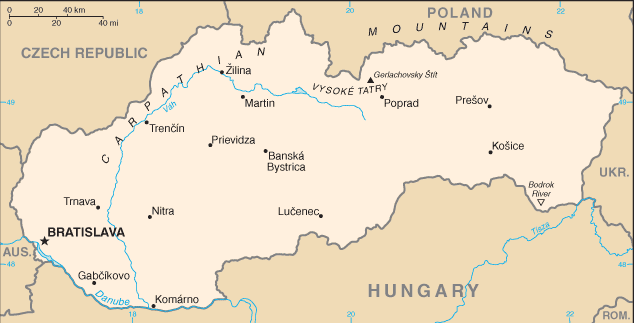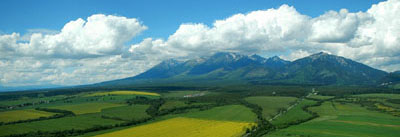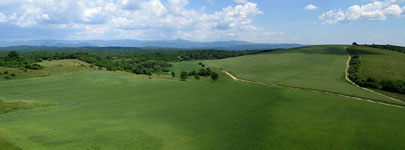
J.S. and S.W. Aber |
| Introduction | High Tatrys |
| Liptov valley | Pieniny Klippen |
| Plavecsky Hrad | Tokaj wine |
| Silica karst | Hornád valley |

J.S. and S.W. Aber |
| Introduction | High Tatrys |
| Liptov valley | Pieniny Klippen |
| Plavecsky Hrad | Tokaj wine |
| Silica karst | Hornád valley |


| Typical power-outlet sockets and plug for Slovakia along with some adapters for American plugs. American plugs include types A and B; most of Europe utilizes types C, E and F—see plug-and-socket types. |
 Near Poprad; assembled from two wide-angle shots. |
![]() Back to top.
Back to top.
Our kite launching site was on the side of one such limestone hogback, which created a strong local updraft. Under partly cloudy conditions, our pictures are mosaicks of sunlit and cloud-shadowed patches on the ground. Beside the village of Kamenica, near Prešov.
The castle is currently undergoing partial reconstruction, and we were invited to conduct KAP. We set up on a nearby hill next to a small chapel. Wind was somewhat erratic, and our KAP session was cut short when clouds moved over the site. Close to the town of Plavec, near Prešov.

| Vineyards extend across southern slopes of the Zemplinske hills (left) near the border with Hungary. Individual fields form intricate patterns on the landscape (right). Note small tractor in lower right corner; it is pulling a sprayer between rows of grape vines. |  |

| Vertical shot (left) and ground view (right) showing alternate row scheme. Every other row is bare for tractors, and intervening rows have plant cover (clover and grass) for walking. Rows are spaced approximately 2 m apart, just wide enough for a small tractor to pass through. |  |

| Tokaj Viewing Tower overview (left) and close-up shot (right). The tower is a Swiss-Slovak project constructed in 2015 to resemble a traditional wine barrel. The top platform stands 12 above ground level, which allows panoramic views of surrounding hillside vineyards. | 
|
 Slovenský Kras (karst) forms the ridge in the far background. Near Košice; assembled from two wide-angle shots. |

| Kite flyers working on a hill top beside a field of grain (left). View over large grain field (right). Note closely spaced rows of grain and distinct tracks left by sprayer. |  |

| Close-up view of grain field (left). Notice red and blue spots which are flowers of corn poppy (Papaver rhoeas) and cornflower (Cyanus segetum). Ground view (right) of flowers and grain. | 
|
![]() Back to top.
Back to top.
Special thanks to TUKE students who assisted with KAP at several
sites: Igor Duriška, Marta Prekopová, and Barbora Zákršmidová.
![]()
All text and images © J.S. and S.W. Aber
![]() Return to KAP gallery.
Return to KAP gallery.
Last update: June 2016.